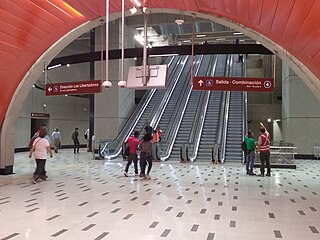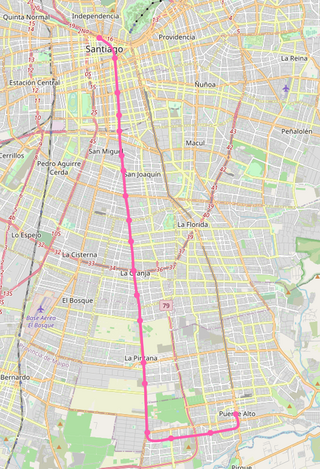
Santiago, also known as Santiago de Chile, is the capital and largest city of Chile and one of the largest cities in the Americas. It is located in the country's central valley and is the center of the Santiago Metropolitan Region, which has a population of seven million, representing 40% of Chile's total population. Most of the city is situated between 500–650 m (1,640–2,133 ft) above sea level.

The Santiago Metro is a rapid transit system serving the city of Santiago, the capital of Chile. It currently consists of seven lines, 143 stations, and 149 kilometres (92.6 mi) of revenue route. The system is managed by the state-owned Metro S.A. and is the first and only rapid transit system in the country.

Plaza Aragón metro station is a station of the Mexico City Metro in the colonias (neighborhoods) of Ignacio Allende and Valle de Santiago, in Ecatepec de Morelos, State of Mexico, in the metropolitan area of Mexico City. It is an at-grade station with one island platform served by Line B, between Ciudad Azteca and Olímpica stations. The name of the station references colloquially the nearby Multiplaza Aragón shopping center; its pictogram depicts a representation of a stand of pots from a tianguis, an open-air market. The station was opened on 30 November 2000, on the first day of service between Ciudad Azteca and Buenavista metro stations. The facilities are accessible to people with disabilities as there are elevators, tactile pavings and braille signage plates. In 2019, Plaza Aragón metro station had an average daily ridership of 19,721 passengers, making it the tenth-most used on the line.

The Plaza de Armas is the main square of Santiago, the capital of Chile. Plaza de Armas metro station is located under the square. Surrounding the square are some historic buildings, including the Metropolitan Cathedral of Santiago, Central Post Office Building, Palacio de la Real Audiencia de Santiago, and the building that serves as the seat of local government for Santiago, which was formerly occupied by the Cabildo of the city before being remodeled. There are also other architecturally significant buildings that face the square, including the Capilla del Sagrario, the Palacio arzobispal, the Edificio Comercial Edwards, and the Portal Fernández Concha. The Casa Colorada, the Cuartel General del Cuerpo de Bomberos de Santiago and the Museo Chileno de Arte Precolombino are located a short walk from the square.

Plaza Egaña is a transfer station between the Line 3 and Line 4 of the Santiago Metro. It is located under Egaña Square. The Line 4 station was opened on 30 November 2005 as part of the inaugural section of the line between Tobalaba and Grecia. The Line 3 station was opened on 22 January 2019 as part of the inaugural section of the line, from Los Libertadores to Fernando Castillo Velasco.

Bellavista de La Florida is an underground metro station on the Line 5 of the Santiago Metro, in Santiago, Chile. The station was opened on 5 April 1997 as the southern terminus of the original extension of the line from Baquedano. It served as the southern terminus of the Line 5 until Vicente Valdés metro station was opened on November 30, 2005. Despite their proximity, there is no direct connection between Bellavista and Vicuña Mackenna metro station.

Plaza de Maipú is an underground metro station on Line 5 of the Santiago Metro, in Santiago, Chile. The station is located under the Plaza de Armas of Maipú. It was formerly the deepest station in the Santiago Metro system at 28 metres (92 ft) deep. However, this has since been surpassed by the Line 3 platforms at Puente Cal y Canto station. The station was opened on 3 February 2011 as the southwestern terminus of the extension of the line from Pudahuel to Plaza de Maipú.

Irarrázaval is a transfer station between the Line 3 and Line 5 of the Santiago Metro. The station is so named due to its location beneath Avenida Irarrázaval, a main road of the commune of Ñuñoa, which in turn was named after the Chilean lawyer and politician Manuel José Yrarrázaval Larraín. The Line 5 station was opened on 5 April 1997 as part of the inaugural section of the line, from Baquedano to Bellavista de La Florida. The Line 3 station was opened on 22 January 2019 as part of the inaugural section of the line, from Los Libertadores to Fernando Castillo Velasco. Construction of the 6.5 km tunnel between Irarrázaval and Fernando Castillo Velasco was completed in 2017 on a budget of 145 million euro.

Santiago Metro Line 5 is one of the seven lines that currently make up the Santiago Metro network in Santiago, Chile. It has 30 stations and 29.7 km (18.5 mi) of track. The line intersects with Line 1 at Baquedano station and San Pablo station, with Line 2 at Santa Ana station, with the Line 3 at both Plaza de Armas station and Irarrázaval station, with Line 4 at Vicente Valdés station, and with line 6 at Ñuble station. It will also intersect and the future Line 7 at Baquedano station. Its distinctive colour on the network line map is green.

Line 3 is a rapid transit line of the Santiago Metro. Traveling from La Reina in the east towards the center, and Quilicura in the North, Line 3 was originally intended to open in the late 1980s, but the 1985 Algarrobo Earthquake hampered its construction, and a subsequent urban explosion in Puente Alto and Maipú further put its construction on hold, until in the early 2010s construction started. The first phase of the project includes 18 stations, which were completed and opened to the public on 22 January 2019 at a cost of US$1.79 billion. The second phase, composed of a three-station extension towards the main square of Quilicura, which was inaugurated on September 25, 2023 with a total project cost of US$378 million. Its distinctive color on the network line map is chocolate brown.

Fernando Castillo Velasco is an underground metro station and the southern terminal station of Line 3 of the Santiago Metro network, in Santiago, Chile. It is located underground, at the intersection of Alcalde Fernando Castillo Velasco Avenue with Loreley Street. It the current terminal station of Line 3, preceded by the Plaza Egaña station. Construction of the 6.5 km tunnel between Irarrázaval and Fernando Castillo Velasco was completed in 2017 on a budget of 145 million euro. The station was opened on 22 January 2019 as part of the inaugural section of the line, from Los Libertadores to Fernando Castillo Velasco.

Villa Frei is an underground metro station of Line 3 of the Santiago Metro network, in Santiago, Chile. It is an underground, between the Chile España and Plaza Egaña stations on Line 3. It is located at the intersection of Irarrázaval Avenue with Ramón Cruz Avenue. The station was opened on 22 January 2019 as part of the inaugural section of the line, from Los Libertadores to Fernando Castillo Velasco.

Chile España is an underground metro station of Line 3 of the Santiago Metro network, in Santiago, Chile. It is an underground, between the Ñuñoa and Villa Frei stations on Line 3. It is located at the intersection of Irarrázaval Avenue with Chile España Avenue. The station was opened on 22 January 2019 as part of the inaugural section of the line, from Los Libertadores to Fernando Castillo Velasco.

Plaza Chacabuco is an underground metro station of Line 3 of the Santiago Metro network, in Santiago, Chile. It is an underground, between the Conchalí and Hospitales stations on Line 3. It is located at the intersection of Independencia Avenue with Hipódromo Chile. The station was opened on 22 January 2019 as part of the inaugural section of the line, from Los Libertadores to Fernando Castillo Velasco.

Conchalí is an underground metro station of Line 3 of the Santiago Metro network, in Santiago, Chile. It is an underground, between the Vivaceta and Plaza Chacabuco stations on Line 3. It is located at the intersection of Independencia Avenue with Dorsal Avenue. The station was opened on 22 January 2019 as part of the inaugural section of the line, from Los Libertadores to Fernando Castillo Velasco.

Vivaceta is an underground metro station of Line 3 of the Santiago Metro network, in Santiago, Chile. It is an underground, between the Cardenal Caro and Conchalí stations on Line 3. It is located at the intersection of Independencia Avenue with Paisaje Vecinal. The station was opened on 22 January 2019 as part of the inaugural section of the line, from Los Libertadores to Fernando Castillo Velasco.

A series of massive demonstrations and severe riots, known in Chile as the Estallido Social, originated in Santiago and took place in all regions of Chile, with a greater impact in the regional capitals. The protests mainly occurred between October 2019 and March 2020, in response to a raise in the Santiago Metro's subway fare, a probity crisis, cost of living, university graduate unemployment, privatisation, and inequality prevalent in the country.

Santiago Metro Line 9 will be a new line that will be part of the Santiago Metro and will have an approximate length of 17 kilometers (11 mi), connecting the communes of Santiago in the center and Puente Alto in the south of the Chilean capital.

An antimonumenta was installed in the Plaza de Armas, in Guadalajara, Jalisco, on 25 November 2020, the date commemorating the International Day for the Elimination of Violence against Women, during the annual march of women protesting against gender violence. The sculpture is symbolically named Antimonumenta and it was inspired by the anti-monument of the same name placed in Mexico City a year prior.

Portal Fernández Concha is a historic mixed-use building in Santiago, Chile. Built in 1871 as a commercial building including a hotel, it forms the south side of the central Plaza de Armas. It was registered on 3 December 1986 as a national monument as part of the zona típica consisting of the square, the former National Congress building and nearby buildings.




















